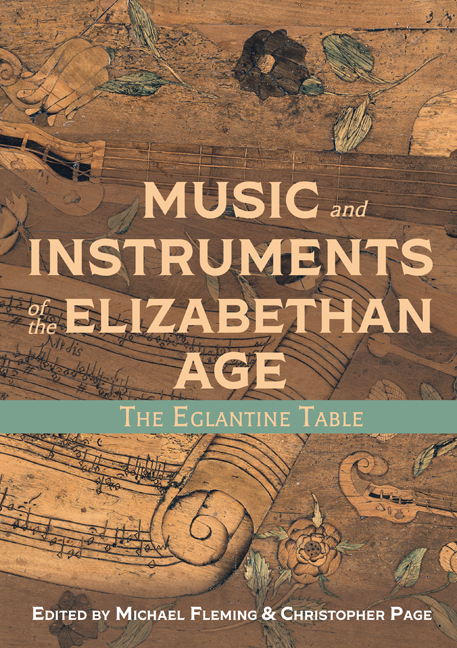Book contents
- Frontmatter
- Dedication
- Contents
- List of Illustrations
- Foreword
- Acknowledgements
- Note to the Reader
- List of Abbreviations
- Introducing the Eglantine Table
- Part I Silent Things
- Part II Music and Instruments
- Part III Broader Views of the Eglantine Table
- Appendices
- Glossary
- Bibliography
- List of Contributors
- Index
- Plate section
3 - The Playing Cards and Gaming Boards
Published online by Cambridge University Press: 24 March 2021
- Frontmatter
- Dedication
- Contents
- List of Illustrations
- Foreword
- Acknowledgements
- Note to the Reader
- List of Abbreviations
- Introducing the Eglantine Table
- Part I Silent Things
- Part II Music and Instruments
- Part III Broader Views of the Eglantine Table
- Appendices
- Glossary
- Bibliography
- List of Contributors
- Index
- Plate section
Summary
When Philip Julius, Duke of Stettin-Pomerania, visited England in 1602, he noted in his travel diary several items of gaming equipment exhibited in Queen Elizabeth's palaces. On 26 September, in the presence chamber at Hampton Court, he saw a table of ‘Brazilian wood inlaid with silver’, on which rested an ebony draught-board, an ivory chessboard and a small ‘table’ bearing seven gold and ivory fifes. At Greenwich four days later, he inspected presents given to Elizabeth by the Earl of Essex, including ‘a golden chess- and draught-board, in the squares of which were embossed in wax … the most eminent German princes’, among them the young duke's father and uncle. The gaming boards shown on the Eglantine Table are not quite so splendid, but are nonetheless very fine; gaming with such opulent resources represented for courtiers a ‘remedy … against slowth’ and idleness. ‘When wee are grown … to a general indisposycyon to all business,’ argued the courtier and writer John Harington (c1517–1582), ‘then commonly wee embrace play to avoyd sleep.’ Following delays to the Earl of Essex's departure for Ireland, John Chamberlain noted that the earl and Robert Cecil ‘have so goode leysure that they plie the tables hard in the presence chamber, and play so round game as yf Ireland were to be recovered at Irish [a precursor of backgammon]’.
Unlike musical instruments, which had to be lifted from a tabletop for use, gaming items required a flat surface, either to rest upon or to be cast onto. Consequently, certain gaming boards portrayed on the Eglantine Table might actually have been used and are shown accordingly. The items appear as though viewed from almost directly above – so that the chessboard, for example, is square in outline, and can be played on – but from a little to one side, discreetly revealing their three-dimensionality (Plate 2). Similar considerations perhaps explain the absence of chess pieces; presented from the same angle, they would be so foreshortened as to be almost unrecognisable.
The Table's chessboard possesses its own inlaid designs (Plate 15). Chequerboard patterns lent themselves to displays of their makers’ skill, including the craft of those who counterfeited them in sweetmeats.
- Type
- Chapter
- Information
- Music and Instruments of the Elizabethan AgeThe Eglantine Table, pp. 47 - 56Publisher: Boydell & BrewerPrint publication year: 2021



